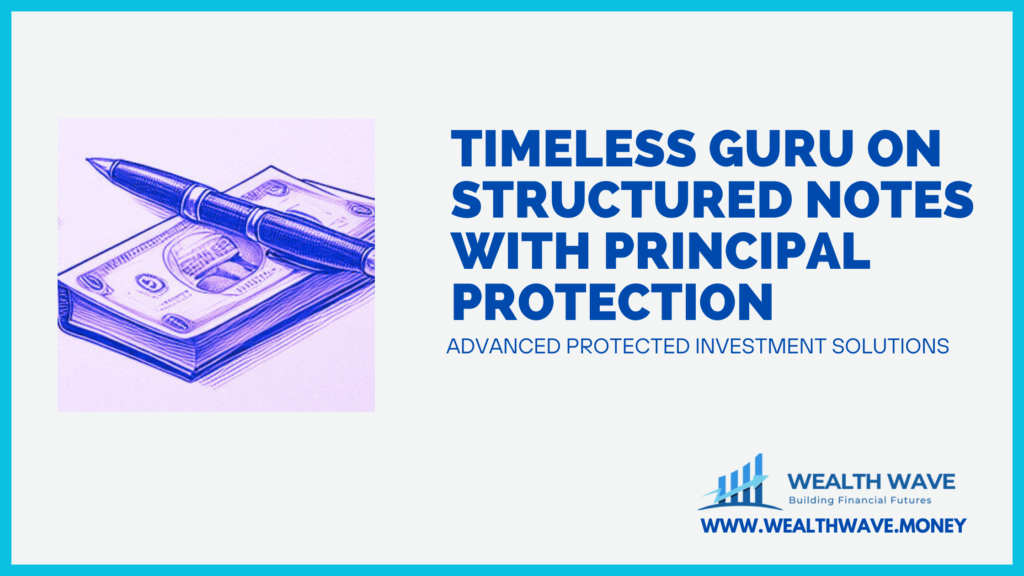Exploring the investment landscape can often feel like wandering through an enigma, with every turn presenting a new option or risk that makes choosing the right path challenging.
Especially when your goal is not just to safeguard your initial investment but also to explore avenues that could potentially enhance it. It’s a balance many of us strive for – holding tight to what we’ve worked hard for while reaching for more.
In our quest for this balance, we stumbled upon an intriguing solution: structured notes with principal protection. Imagine this: the fusion of a zero-coupon bond and derivative instruments, such as options on stock market indices.
This blend aims to return your initial investment at maturity, alongside potential upside if the markets perform strongly. It’s appealing because it offers a safety net for your capital while providing a glimpse into the possible rewards of market performance.
Our exploration into these financial vehicles illuminated their role in diversifying portfolios and achieving varied financial objectives. Through this guide, you’ll learn to understand the essence of structured notes with principal protection—exploring their key characteristics, unraveling how returns are calculated, and assessing risks before making any investment moves.
Prepare yourself to discover an alternative pathway towards diversifying your portfolio.
Key Takeaways
- Structured notes with principal protection mix bonds and derivatives to keep your main investment safe until the note matures. These notes can give back your initial investment plus extra earnings if the markets do well.
- Investors need to pick structured notes from reliable companies because these notes’ safety comes from the issuer’s ability to pay back. If a company goes under, like Lehman Brothers did in 2008, you might lose your money despite the promised protection.
- The costs and fees for structured notes can average around 2.9%. Since these fees might not be clear upfront, it’s important to read all documents carefully before investing.
- When you earn money from structured notes, you have to pay federal taxes on those gains at regular income rates even before the note reaches its end date. Also, keep in mind that dividends from underlying assets aren’t included when figuring out how much tax you owe.
- Before putting money into structured sections with principal protection, think about how easily you’ll need access to your money (liquidity), make sure they fit with your investment goals, and check that you’re okay with the risks involved.
Overview of Structured Notes with Principal Protection
Structured notes with principal protection blend the stability of bonds with the thrill of derivatives, offering a unique way to dip our toes into market gains while safeguarding our core investment until maturity.
Unlike mutual funds or ETFs that hold a basket of securities, these special products deliver payouts based on how well certain equities, currencies, or commodities perform.
While it’s true that not all structured products shield your initial investment, those known as principal protected notes (PPNs) stand out for doing just that. By holding onto these notes until they mature, we can breathe easier knowing we should recoup our full original investment—plus possibly enjoy some extra returns tied to selected market benchmarks.
This aspect is particularly comforting for anyone wanting to chase higher yields without risking their primary stake under unpredictable market skies.
Key Features of Structured Notes with Principal Protection
Structured notes with principal protection provide safeguarding for the invested capital by offering a safety net against market downturns. Investors benefit from exposure to diverse asset classes, allowing for potential growth while protecting their principal investment.
Protecting the Principal: How It Works
We use tools like barriers and buffers to protect the money you put into structured notes. Barriers are set levels that, if crossed, can put your initial investment at risk. On the other hand, buffers aim to limit any loss of principal only to amounts over a certain threshold.
This means if the market drops slightly below the buffer level, your original investment might still be safe.
Your investment’s safety hinges on our chosen structures.
Our careful selection aims to guard against big losses by using these financial cushions. Yet, it’s crucial for us to pick strong companies for issuing structured notes because their stability backs up this protection promise.
Moving forward from protecting principals lets us delve into how we figure out profits in structured projects.
Calculating Performance in Structured Notes
After ensuring the principal is secure, we focus on how these notes perform. The performance of structured notes depends on certain formulas linked to the achievements of reference assets like stocks or equity indices.
These methods include point-to-point, high water mark, accrual, range, and conditional strategies.
We look at market-linked gains or losses through a magnifying glass. Participation rates play a big role too. They show us how much of the gain from underlying assets gets added to our note’s value.
Some offer more returns than just following the asset directly. This way, investors can potentially earn more compared to traditional investment vehicles while keeping an eye on their initial capital’s safety.
Advantages and Disadvantages of Structured Notes
Structured notes have tailored payouts and offer market exposure to investors. They provide enhanced returns, but they come with limited liquidity and fixed pricing.
Investors are attracted to structured notes due to their customized payouts and exposure to the market. However, they should be aware of the drawbacks such as limited liquidity and potential call risks.
Benefits: Tailored Payouts, Market Exposure, Enhanced Returns
We offer personalized payouts, exposure to financial markets, and chances for better returns with structured notes that protect the initial investment. These products let us mix different investments like fixed income, stocks, and derivatives.
This approach helps match your risk level with potential gains based on how well the underlying assets do.
By choosing these structured notes, we can tap into broader market movements without risking all our principal. They often outdo regular bonds with fixed interest rates because of their link to diverse financial instruments.
This way, investors can enjoy higher returns while keeping a safety net under their capital. Exposure to various assets also means we get more ways to grow our money in alignment with market trends.
Downsides: Limited Liquidity, Fixed Pricing, Exposure to Call Risk
Structured notes with principal protection come with drawbacks investors should consider. Limited liquidity means these notes are not easily sold before maturity, potentially tying up funds for extended periods.
Additionally, fixed pricing can hinder potential returns as it limits the ability to benefit from market gains. Exposure to call risk adds another layer of uncertainty, as issuers may redeem the notes early, impacting potential earnings.”.
Considering these downsides is crucial when evaluating structured notes’ suitability for our investment strategy.
Protective Mechanisms in Structured Notes
Protective mechanisms in structured notes act as safeguards against market volatility, managing risk and protecting the principal investment. These mechanisms include barriers and buffers which define how much of the market movement impacts the principal.
Barriers provide protection up to a certain level where if the underlying asset value falls beyond that point, it starts impacting the principal. Buffers offer partial shield by absorbing a portion of losses within a defined range before affecting the principal.
Understanding these protective features is crucial for investors looking to mitigate downside risk while seeking exposure to potential gains.
The varied nature of protective mechanisms underscores their importance in determining structured notes’ performance under different market conditions. While barriers and buffers can limit potential returns, they enhance security by shielding against significant downturns in underlying assets, contributing to overall stability within an investment portfolio.
Associated Costs and Fees with Structured Notes
Explore the expenses and charges related to structured notes.
Read on for a detailed breakdown.
Overview of Charges
When considering structured notes, it’s crucial to understand the associated costs and fees that can impact your investment. In 2020, structured notes carried an average embedded fee of 2.9%, which can be challenging for investors to discern due to potential hidden or imputed costs.
It’s essential to carefully review the prospectus to assess the minimum guaranteed return and fully comprehend the overall expenses involved in structured notes before making any investment decisions.
Moving on from understanding charges, let’s explore the tax implications for investors when delving into structured notes.
Tax Implications for Investors
Investors face federal taxes on gains from structured notes at the ordinary income rate, which must be paid even before maturity. It’s crucial to consider these tax implications when contemplating investment in structured notes.
Additionally, it’s important to note that structured notes usually exclude dividends from underlying investments, affecting how they are taxed and is a significant factor for investors to weigh when making decisions.
Investors should be aware of the tax implications related to structured notes as they can impact overall returns. In particular, considering that federal taxes are applied to gains from structured notes at the ordinary income rate and may need to be paid before maturity.
The exclusion of dividends from underlying investments in the taxation process also plays a pivotal role in determining returns for investors involved with these investment products.
Calculating Returns on Structured Notes
7. Calculate returns by analyzing the overall performance and considering factors affecting the investment. For further insights, delve into our comprehensive guide on structured notes with principal protection.
Methods to Determine Returns
To determine returns on structured notes, we can use the following methods:
- Market-Linked Gains or Losses: Use formulas like point-to-point, high water mark, accrual, range, and conditional formulas to calculate market-linked gains or losses.
- Participation Rates: Assess how much gain from the underlying asset will be credited to the note based on participation rates.
- Guaranteed Return Review: Review the minimum guaranteed return in the prospectus to understand its impact on performance.
- Performance Formula: Understand that performance is dictated by a formula based on the performance of reference assets, which determines the actual returns.
Elements Affecting Performance
Understanding the elements that affect the performance of structured notes is crucial for investors. Here are the key factors to consider:
- Reference Asset Performance: The underlying performance of the reference asset directly impacts the structured note’s returns.
- Volatility Levels: Higher volatility in the market can affect the pricing of structured notes and their potential returns.
- Interest Rate Movements: Changes in interest rates can influence the value and performance of structured notes.
- Credit Risk: The credit quality of the issuer affects both the pricing and risk profile of structured notes.
- Market Conditions: Overall market conditions, including liquidity and investor sentiment, play a role in determining structured note performance.
- Derivative Components: The use of derivatives within structured notes can introduce complexities and affect their overall performance.
These elements collectively contribute to the overall performance and risk profile of structured notes with principal protection, influencing investment outcomes for investors.
Understanding Risks in Structured Notes
Understanding the risks in structured notes is crucial for investors. It’s essential to grasp potential downsides before making investment decisions. Read more about this topic on our website.
The Impact of Credit Risk
Credit risk poses a substantial threat if the bank issuing structured notes fails, as evidenced by the collapse of Lehman Brothers in 2008. The protection of principal depends on the creditworthiness of the issuer.
Structured notes are debt obligations that contain an embedded derivative element and may not be entirely secure, despite being principal-protected notes (PPNs) guaranteeing initial investment return by the issuer.
Furthermore, these PPNs are not devoid of risks due to significant exposure to credit risk inherent in their structure. As such, evaluating the creditworthiness of issuers is crucial when considering investments in structured notes with principal protection to mitigate potential losses stemming from credit defaults.
Challenges with Pricing Accuracy
Assessing the fair value of structured notes can be complex due to their intricate terms and structures, leading to challenges in determining accurate pricing. The imputed costs associated with these notes might not always be transparent, making it difficult for investors to fully grasp the true expenses involved.
Furthermore, understanding the impact of these costs on potential returns adds an additional layer of complexity when evaluating the accuracy of pricing for structured notes.
In some cases, comparing pricing across different types of structured notes can be challenging due to the variations in principal protection levels and hidden costs. Additionally, determining accurate pricing for these notes is crucial as it directly influences investors’ ability to make informed decisions regarding their investments in this realm and assess potential risks effectively.
Exploring Additional Risks
Exploring additional risks in structured notes involves considering the potential effects of volatile markets on these investments. As we explore credit risk and pricing accuracy, it’s important to recognize the impact they can have.
Credit risk encompasses the possibility of an issuer defaulting on payments, posing a significant threat to investors’ principal protection. Additionally, challenges with pricing accuracy can affect the overall performance and returns of structured notes, influencing investment outcomes significantly.
It’s essential for investors to be aware of these factors when evaluating their options within this realm and making well-informed decisions regarding their portfolios.
Considerations Before Investing in Structured Notes
Before investing in structured notes, consider your liquidity requirements, align with investment objectives and assess your risk comfort levels. Determine how these investments suit your needs rather than focusing solely on potential returns.
Evaluating Liquidity Requirements
When considering structured notes with principal protection, it is crucial to thoroughly assess the liquidity requirements. Due to their limited listing on exchanges and rare secondary market trading post-issuance, structured notes may pose potential challenges in terms of accessing funds when necessary.
These factors can substantially impact an investor’s ability to swiftly liquidate their position or find a buyer for the note. Additionally, protective mechanisms like barriers and buffers designed to safeguard the principal may further impair liquidity and redemption options.
In light of these aspects, evaluating liquidity requirements becomes paramount in making informed decisions about investing in structured notes with principal protection. The potential tie-up of capital over extended periods and the scarcity of tradable markets underscore the need for a meticulous examination of one’s liquidity needs before delving into this investment avenue.
Aligning with Investment Objectives
When considering structured notes, it’s crucial to align with our investment objectives. We must evaluate if the notes fit within our portfolio diversification strategy and understand how they contribute to our risk management goals.
It’s essential to carefully assess if the potential returns from structured notes align with the total return expectations we have set for our investment endeavors, ensuring that they meet our financial aspirations while safeguarding against downside risks.
Investors should also consider the impact of fees and costs associated with structured notes on their investment objectives. By critically analyzing these factors, we can ensure that investing in structured notes resonates with our overall long-term wealth accumulation and preservation plan, helping us achieve a balanced approach to growing and protecting our assets.
Assessing Risk Comfort Levels
When assessing risk comfort levels for structured notes, we must consider the level of protection provided by the issuer’s creditworthiness and whether it aligns with our investment objectives.
It is imperative to evaluate potential losses, lock-up periods, selling options, and call features before investing. Additionally, understanding associated costs such as tax implications and credit risks will help us make well-informed decisions about our investments in structured notes.
Investors should carefully analyze their liquidity requirements and determine if the protection levels offered by structured notes meet their risk comfort levels. Moreover, meticulous consideration of the ever-evolving market conditions and potential risks related to these investment instruments is crucial in making informed choices.
Structured Notes with Principal Protection a secure way to invest
Structured notes with principal protection combine a bond and derivative component to secure the return of the principal at maturity. These notes are not risk-free despite their seemingly secure terms.
Some provide full principal protection if held until maturity, achieved through predetermined threshold levels acting as triggers for protection. Structured notes offer potentially solid returns compared to directly investing in underlying assets under specific market conditions.
It’s crucial for investors to understand associated fees, risks, call provisions, and minimum guaranteed returns before investing in these complex financial instruments.
FAQs
1. What are structured notes with principal protection?
Structured notes with principal protection are a type of investment where the guarantor promises to protect our capital. This means if the market drops, we won’t lose our initial investment.
2. How do they work to protect our money?
These investments use hedging strategies and sometimes involve fixed-income investments or exchange-traded funds (ETFs) to safeguard against downside risk. If things go bad in the market, these strategies help keep our original amount safe.
3. Can we still make money from them?
Yes, we can earn capital gains if the market does well. The rate of return depends on several factors like market performance and the terms set by the issuer.
4. Should we talk to an investment adviser before buying structured notes?
Definitely! An investment advisor can offer personalized advice based on our financial goals and risk tolerance. They’ll explain how these products fit into our portfolio management strategy.
5. Are there any risks involved?
While the principal is protected, there’s still some level of investment risk such as credit risk from the guarantor or lower returns compared to direct investments in stocks or ETFs due to caps on potential gains.
6. Do all investors suit structured notes with principal protection?
Not always; it’s ideal for those seeking downside protection while willing to accept limits on potential upside gains—often appealing to people who want a safer alternative but wish for more than what traditional savings accounts offer.




